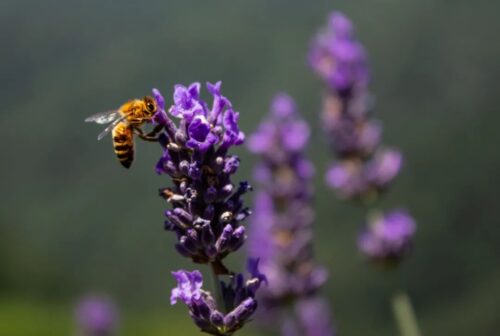
Lavender Spike
Lavandula latifolia
【Overview】
Origin | Spain
Plant Family | Lamiaceae
Plant Odor | It has a mixture of grassy and herbal scents, providing a refreshing aroma that can invigorate the mind. However, the scent may vary depending on the chemical composition of the origin.
Extraction Part | Whole plant
Extraction Method | Distillation

【Main Benefits】
◇ Main Components|Linalool (20-50%), 1,8-Cineole (20-35%), Camphor (8-20%) Borneol
Linalool (20-50%), 1,8-Cineole (20-35%), Camphor (8-20%), Borneol, as well as trace amounts of limonene, pinene, and other components. These components give it anti-inflammatory, expectorant, pain-relieving, and antimicrobial properties. It is often used to help with muscle spasms, respiratory issues, and skin conditions due to its high proportion of monoterpenes.
【Component Analysis】
1. (R)(-)-Linalool

Linalool, also known as "coriandrol," can be further classified as "linalool oxide" and "coriandrol oxide" based on its structure. It is a common aromatic molecule used extensively in the perfume industry for creating various floral scents.
There are two optical isomers of linalool, the "R" and "S" forms, as well as a third "racemic" form. Each has slight olfactory differences, with the "R" form of linalool being more commonly encountered.
Linalool is a gentle ingredient suitable for use on infants and children. It has mild antimicrobial properties and enhances environmental resilience.
• Benefits: Overall antimicrobial and anti-pathogen properties (particularly in the respiratory, digestive, and urinary systems), nerve calming, sleep aid
• Uses: Fragrance, raw material for synthesizing vitamins E and K
2. 1,8 Cineole
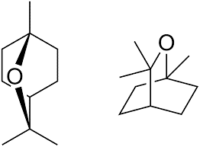
With a small molecular size, 1,8-cineole exhibits strong expectorant and mucosal repair properties, helping to prevent pathogen invasion.
• Benefits: Prevents respiratory pathogen invasion, stimulates environmental resilience, expectorant, analgesic, anti-inflammatory, purifying, preservative
• Uses: Everyday products, personal hygiene or cosmetic fragrances. Can be used in industrial products for air freshening. Food flavoring.
3. Camphor

• Chemical Structure: Ketone
• Benefits: Skin protection, antimicrobial, insect repellent, air freshening, component of local analgesics
• Uses: Pharmaceuticals and important industrial raw materials
➢ Comparison of Lavender Varieties
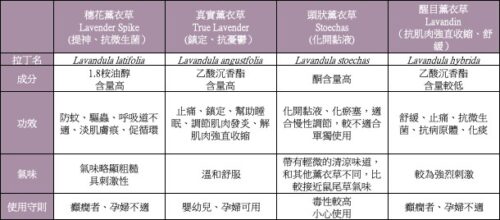
【Market Applications】
◇ Uses/Features:
➢ The results of research on true lavender and lavender spike essential oils can serve as reference indicators for the development of various skin-regulating botanical cosmetics and herbal medicine ingredients.
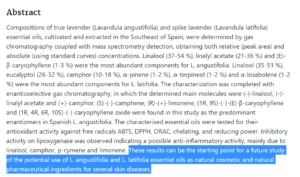
➢ By-product of distillation can be utilized as a source of plant antioxidant agents for value-added purposes.
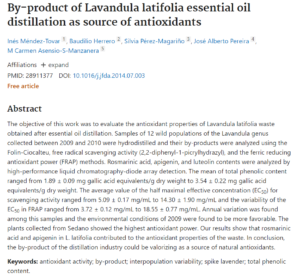
1. Skincare Products:
Benefits: Cleansing, antimicrobial, facial skincare, soothing inflammation, regulating and purifying the skin, promoting skin repair.
Examples: Facial soaps, cleansing mousses, toners, serums, lotions, skin-regulating essences, creams, eye creams, etc.
2. Body Care Products:
Benefits: Antimicrobial, soothing inflammation, relieving itching, alleviating discomfort in the skin, promoting circulation, addressing bruises, pain, cracked hands, aiding in unexpected skin repair.
Examples: Shampoos, body washes, soothing lotions, healing balms.
3. Daily Necessities Products:
Benefits: Soothing and calming breathing, refreshing the head, alleviating headaches caused by nasal congestion or mucosal inflammation, relieving respiratory discomfort, preventing upper respiratory discomfort, invigorating and energizing, stabilizing nerves, aiding in unexpected skin repair, providing pain relief primarily for muscle and rheumatic pain.
Examples: Massage oils, cooling sticks, pain relief balms, burn and scald repair balms, etc.
4. Environmental Cleaning Products:
Benefits: Antimicrobial, air purification.
Examples: Purifying sprays, antimicrobial hand soaps, insecticides, and repellents.
【Product Description】
◇ Formulation Applications/Usage:
• Addressing respiratory system issues such as cough, excessive phlegm, respiratory discomfort, air purification.
• Treating unexpected skin injuries.
• Antimicrobial effects.
◇ Precautions:
• Please adjust the usage ratio according to individual skin conditions.
• This product is a raw material, and it is recommended to dilute before use.
• Perform a patch test on a small area of the skin before applying to the face.
• Please use in normal dosage.
Reference|
1. Bernstein N, Akram M, Yaniv-Bachrach Z, Daniyal M. Is it safe to consume traditional medicinal plants during pregnancy? Phytother Res. 2021 Apr;35(4):1908-1924.
2. Karaca N, Şener G, Demirci B, Demirci F. Synergistic antibacterial combination of Lavandula latifolia Medik. essential oil with camphor. Z Naturforsch C J Biosci. 2020 Nov 2;76(3-4):169-173.
3. Alonso C, Pérez R, Bazaga P, Medrano M, Herrera CM. Within-plant variation in seed size and inflorescence fecundity is associated with epigenetic mosaicism in the shrub Lavandula latifolia (Lamiaceae). Ann Bot. 2018 Jan 25;121( 1):153-160.
4. Herrera CM, Alonso C, Medrano M, Pérez R, Bazaga P. Transgenerational epigenetics: Inheritance of global cytosine methylation and methylation-related epigenetic markers in the shrub Lavandula latifolia. Am J Bot. 2018 Apr;105(4):741 -748.
5. Alejandro Carrasco, Ramiro Martinez-Gutierrez , Virginia Tomas , Jose Tudela. Lavandula angustifolia and Lavandula latifolia Essential Oils from Spain: Aromatic Profile and Bioactivities. Planta Med. 2016 Jan;82(1-2):163-70.
6. Carrasco A, Martinez-Gutierrez R, Tomas V, Tudela J. Erratum for: Lavandula angustifolia and Lavandula latifolia Essential Oils from Spain: Aromatic Profile and Bioactivities. Planta Med. 2016 Jan;82(1-02):E4.
7. Méndez-Tovar I, Herrero B, Pérez-Magariño S, Pereira JA, Asensio-S-Manzanera MC.By-product of Lavandula latifolia essential oil distillation as source of antioxidants. J Food Drug Anal. 2015 Jun;23(2 ):225-233.
8. Rodrigues N, Malheiro R, Casal S, Asensio-S-Manzanera MC, Bento A, Pereira JA. Influence of spike lavender (Lavandula latifolia Med.) essential oil in the quality, stability and composition of soybean oil during microwave heating. Food Chem Toxicol. 2012 Aug;50(8):2894-901.
9. Cavanagh HM, Wilkinson JM. Biological activities of lavender essential oil. Phytother Res. 2002 Jun;16(4):301-8.
10. Gamez MJ, Zarzuelo A, Risco S, Utrilla P, Jimenez J. Hypoglycemic activity in various species of the genus Lavandula. Part 2: Lavandula dentata and Lavandula latifolia. Pharmazie. 1988 Jun;43(6):441-2.
|Some images sourced from the internet. Contact for copyright removal.|
For more exciting content, please contact Pureness' official LINE@ account! (Click to add)
